Choosing the right area rug can change a room’s feel. But, where do you start? How do you pick one that looks great and works well? This rug selection guide will show you how to find the perfect rug for your space.
Key Takeaways
- Area rugs can instantly transform the look and feel of a room, adding personality, coziness, and improved acoustics.
- Rugs help define floor plans, protect flooring, provide traction, and insulate spaces.
- Selecting the right rug involves considering factors such as room location, material, aesthetic, and size.
- High-quality rugs are typically made from natural materials like wool, cotton, or jute.
- Durable options include wool, nylon, and polypropylene rugs.
So, what’s the secret to finding the perfect rug for your home? Let’s dive in and uncover the answers together.
Why Every Room Needs an Area Rug
Area rugs can change the look and feel of any room. They add personality and style. Plus, they have many practical benefits that make them key to a well-designed space.
Rug Selection Guide Style Benefits
Rugs come in many rug styles. They can match or contrast your decor. Whether you like bold patterns, soft textures, or classic solids, a rug can anchor the room’s design.
By defining zones and adding visual interest, rugs can make any room look better.
Functional Benefits
Rug benefits go beyond looks. They provide traction to prevent slips and falls. They also insulate better than bare floors.
This is great in rooms with hard surfaces, like kitchens and hallways. It adds comfort and safety.
Comfort and Acoustics
The soft feel of an area rug makes a room cozy and inviting. Rugs also improve room acoustics. They absorb sound and reduce echo, making the space more pleasant for conversation and relaxation.
Area rugs are essential for adding personality, improving functionality, and creating a cozy atmosphere. They are a must-have in any well-designed room.
Understanding Rug Materials and Their Properties
Choosing the right rug for your home is important. Knowing about different rug materials helps a lot. Each material has its own benefits that can make your room look and feel better.
Wool is a top choice for rugs. It’s known for being very durable and good at keeping moisture away. Wool rugs also fight off dust mites and bacteria. They’re great for busy areas because they’re soft yet strong.
Synthetic and natural woven materials like jute and sisal have their own perks. These rugs are easy to clean and last a long time. They’re perfect for homes with pets or kids.
Natural materials and handwoven rugs might cost more. But they’re worth it. They bring timeless beauty and are better for the environment than machine-made rugs.
Vintage rugs add a special touch to any room. Made from wool, they’re both charming and durable. They’re also good for the planet.
Choosing a rug depends on what you need and like. Knowing about different materials helps you pick the best one. This way, your home will look and feel amazing.
Rug Selection: Essential Factors to Consider
Choosing the right rug for your space is all about considering a few key things. Think about the room’s purpose, how much traffic it gets, and your lifestyle and budget. Each of these factors is important to make sure your rug looks good and works well in your home.
Room Purpose and Traffic
First, think about what the room is for. Rooms that get a lot of use, like living rooms and hallways, need strong rugs. These rugs should last even when many people walk on them. In places like kitchens and bathrooms, where it’s wet, choose rugs that can handle moisture well.
Lifestyle Requirements
Your lifestyle and who lives with you also matter. If you have kids or pets, you might want a rug that’s easy to clean. For a fancy look, go for soft, high-quality materials. Think about how the rug fits into your daily life.
Budget Considerations
Don’t forget about your budget. Rugs made from natural materials like wool and silk, or handwoven ones, cost more. Decide how much you can spend and whether it’s worth it to get a better rug that lasts longer. Or, if you just need something for now, there are cheaper options too.
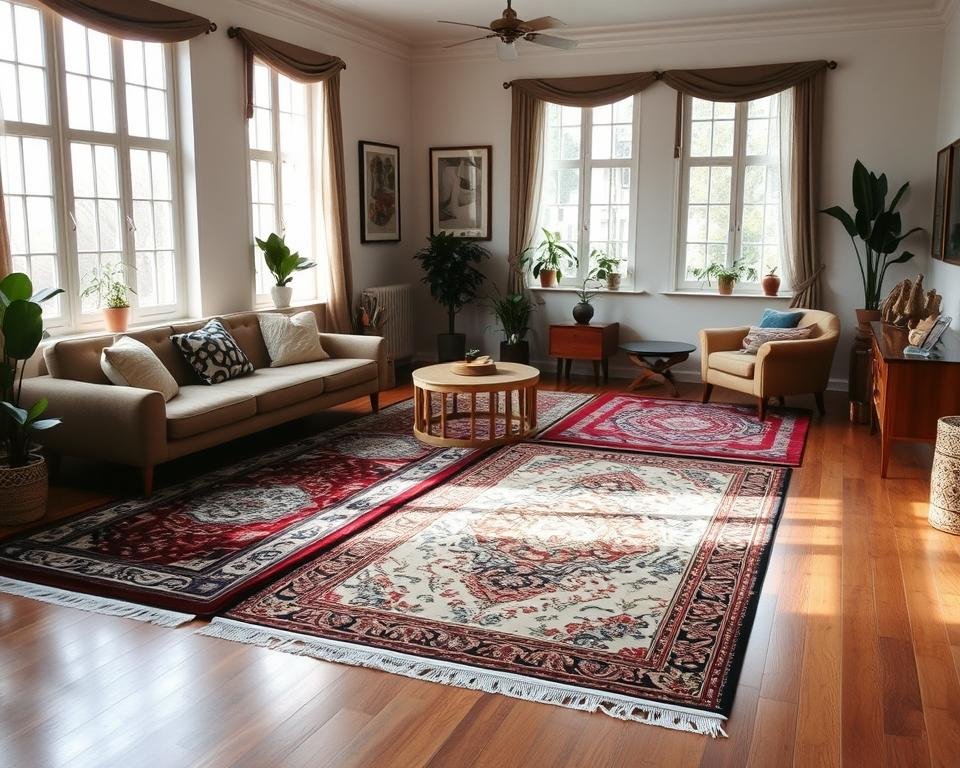
“The right rug can transform a room, adding warmth, texture, and a cohesive design aesthetic. By carefully considering the room’s purpose, your lifestyle, and your budget, you can find the perfect rug to enhance your living space.”
Living Room Rug Sizing Guidelines
Choosing the right size for your living room rug is key. The right rug can tie your furniture together, set the room’s boundaries, and boost its look. Experts say the usual sizes for living room rugs are 8’x10′ to 9’x12′.
In a small room of about 150 square feet, a 6’x9′ rug is best. For a room of around 200 square feet, an 8’x10′ or 9’x12′ rug is common. For bigger rooms, around 300 square feet, a 9’x12′ rug or bigger is suggested.
When picking a rug size, make sure it’s 6 to 8 inches wider than your sofa on both sides. The rug should also cover the length of the sofa and leave 30 to 36 inches of space between big furniture. If your room is small and your budget is tight, a smaller rug in front of the furniture works, even if the sofa is against a wall.
- Rugs should typically be 8’x10′ or 9’x12′ for living rooms, while 6’x9′ rugs are often used for smaller living rooms.
- Coffee tables should ideally be ⅖ to ⅗ the width of the rug in a living room.
- Leave at least 24 inches of space between furniture items in your living room.
A rug that’s too big can make the room feel tight and unbalanced. On the other hand, a rug that’s too small can make the room look uneven. It’s important to measure carefully and pay attention to online product descriptions to find the perfect size for your living room rug.
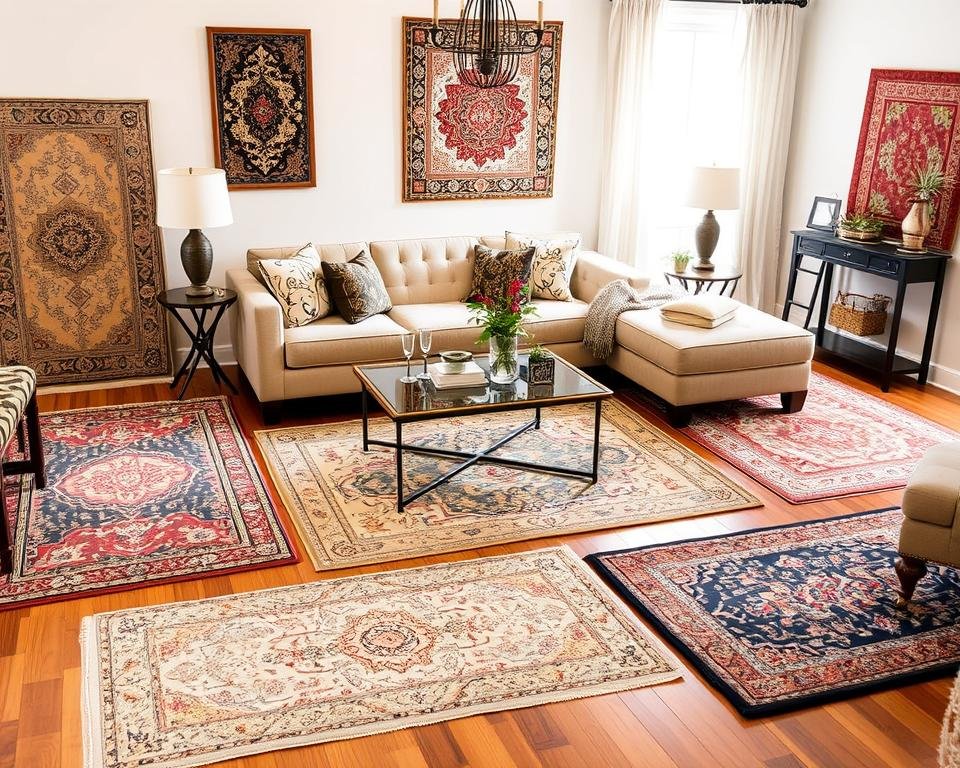
Choosing the Perfect Dining Room Rug
Choosing the right rug for your dining room is important. The size, material, and style of the rug greatly affect the look and feel of the room. Here are the key guidelines for picking the perfect dining room rug.
Size Requirements
Dining room rugs usually come in 8’x10′ and 9’x12′ sizes. Make sure to leave at least 36 inches between the rug and your dining table. This allows chairs to move easily. Also, keep 12 inches between the rug and the wall for a nice design.
Practical Considerations
When placing a dining room rug, think about practicality. Flatweave rugs are great because they’re easy to clean and chairs slide smoothly. Tufted or low-pile rugs also work well. But, avoid shags and thick piles as they’re hard to keep clean and may catch food.
Style Recommendations
The style of your dining room rug should match the room’s look. Choose a rug that complements your furniture and decor. Neutral colors like beige, gray, or navy are good choices as they fit well with many designs.
| Rug Material | Durability | Maintenance | Pricing |
|---|---|---|---|
| Wool | Highly Durable | Easy to Clean | $300 – $500 |
| Cotton | Moderate Durability | Easy Maintenance | $50 – $200 |
| Polypropylene | Highly Durable | Stain-Resistant, Washable | $100 – $300 |
| Nylon | Durable | Washable | $150 – $400 |
By thinking about size, practicality, and style, you can find the perfect dining room rug. It will make your space look better and work better for dining.
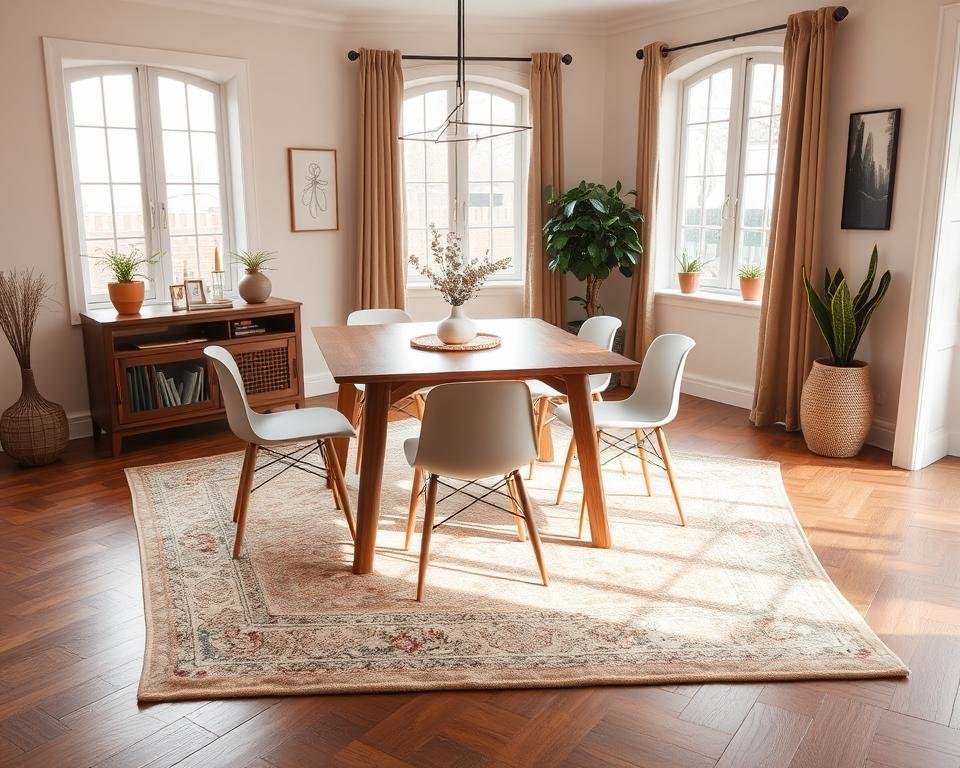
Bedroom Rug Selection Guide Placement and Sizing
Choosing the right bedroom rugs is key to a balanced look. The rug should extend 18 to 24 inches beyond the bed’s sides and foot. This makes the room look good and in proportion.
For a twin bed, a 5’x8′ rug is best. A full-size bed needs a 6’x9′ rug. A queen-size bed looks great with an 8’x10′ rug, and a king-size bed fits well with a 9’x12′ rug. The rug’s length should be across the bed, with the footboard’s legs on it for a neat look.
| Bed Size | Recommended Rug Size |
|---|---|
| Twin | 5’x8′ |
| Full | 6’x9′ |
| Queen | 8’x10′ |
| King | 9’x12′ |
Make sure there’s enough space between the rug and walls, 10 to 24 inches. This creates a balanced and pleasing look. By following these rug placement tips, you can make your bedroom cozy and inviting.
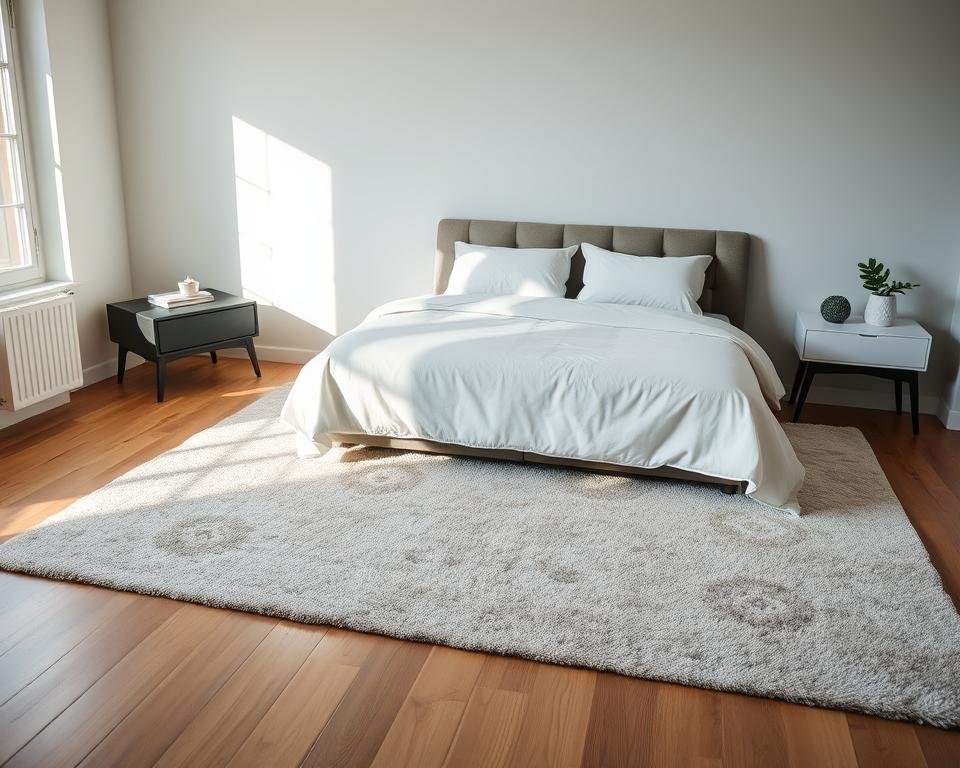
Color Selection and Pattern Coordination
Choosing the right area rug is key to a beautiful room. The rug’s colors and patterns should match the room’s elements. This creates a space that looks intentional and harmonious.
Color Psychology
Colors can change how a room feels. Lighter rug colors like beiges make rooms feel open. Darker rug colors like chocolates add coziness. Pick a rug color that fits the room’s colors well.
Pattern Mixing Tips
- Embrace contrast: A patterned rug can add interest to solid-colored furniture.
- Vary the scale: Mix rug patterns of different sizes for a layered look.
- Coordinate within a color scheme: Use the same colors but different rug patterns for a unique look.
Design Balance
Balance is important in design. Darker rug colors and bold rug patterns ground a room. Lighter rug colors and simple rug patterns add elegance.
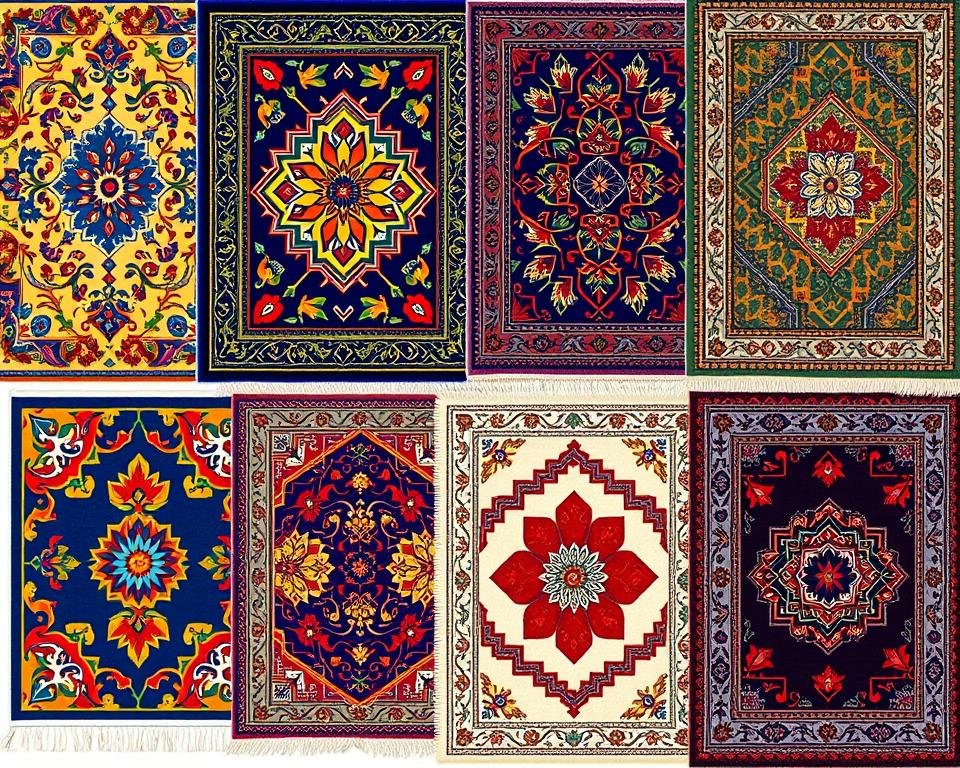
“The right rug can instantly transform a room, adding depth, warmth, and personality to the space.”
Think about color, pattern, and balance when choosing a rug. This way, you can make a space that’s both beautiful and reflects your style.
Natural vs Synthetic Rug Materials
Choosing the right area rug for your home is key. Natural rugs come from materials like wool, cotton, and jute. They are durable, eco-friendly, and comfy. Synthetic rugs, made from man-made rug fibers, are cheaper and easier to keep clean.
Wool rugs are great for those with allergies. They trap allergens and resist dust mites. These rugs last over a decade. Synthetic rugs, on the other hand, are more affordable because they’re made in factories.
| Natural Rugs | Synthetic Rugs |
|---|---|
| Durable, with an average lifespan of 10+ years | Often more affordable than natural rugs |
| Eco-friendly and biodegradable | Easier to clean and maintain |
| Offer a rustic, natural aesthetic | Tend to have a modern, vibrant design |
| Wool rugs are excellent for allergy sufferers | Synthetic fibers like nylon and polypropylene offer durability |
Think about what matters most to you when choosing between natural rugs and synthetic rugs. Do you want durability, easy cleaning, eco-friendliness, or a good price? The best choice depends on your needs and what you like.
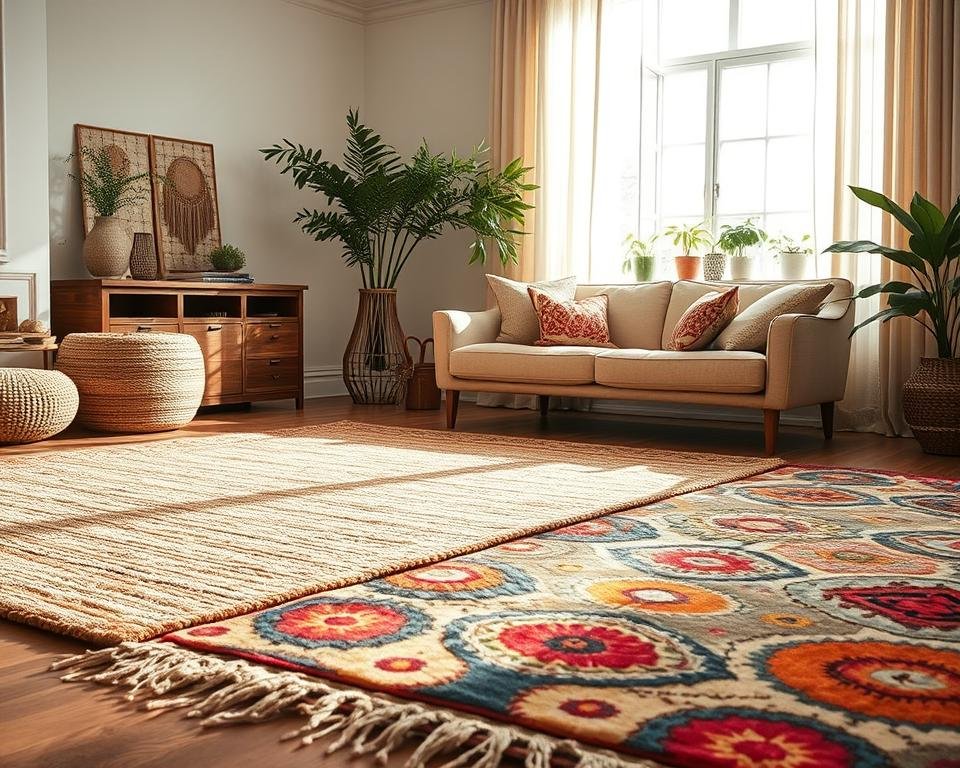
“Wool rugs are known for their exceptional durability, often lasting over a decade with proper care and maintenance.”
Maintenance and Care Requirements
Keeping your rug in top shape is essential. Cleaning needs differ by material, but some steps are universal. These can help your rugs stay beautiful for a long time.
Cleaning Methods
Vacuuming regularly is a must. But, be careful with your rug’s type. Beater bars can damage certain fibers. A suction-only canister vacuum is usually the safest choice.
For wool rugs, a vacuum with brush rolls is best. Treat spills right away with the right cleaning solutions. Don’t soak the rug too much and rinse with warm water. Also, using mats and moving heavy furniture helps your rugs last longer.
Professional Care
Even with good home care, your rugs might need professional help sometimes. Choose rug cleaners certified by the Carpet and Rug Institute (CRI). They have the skills and tools to deep clean your rugs.
By following the care instructions and regular maintenance, your floors will stay clean. A well-maintained rug can be a lasting part of your home.
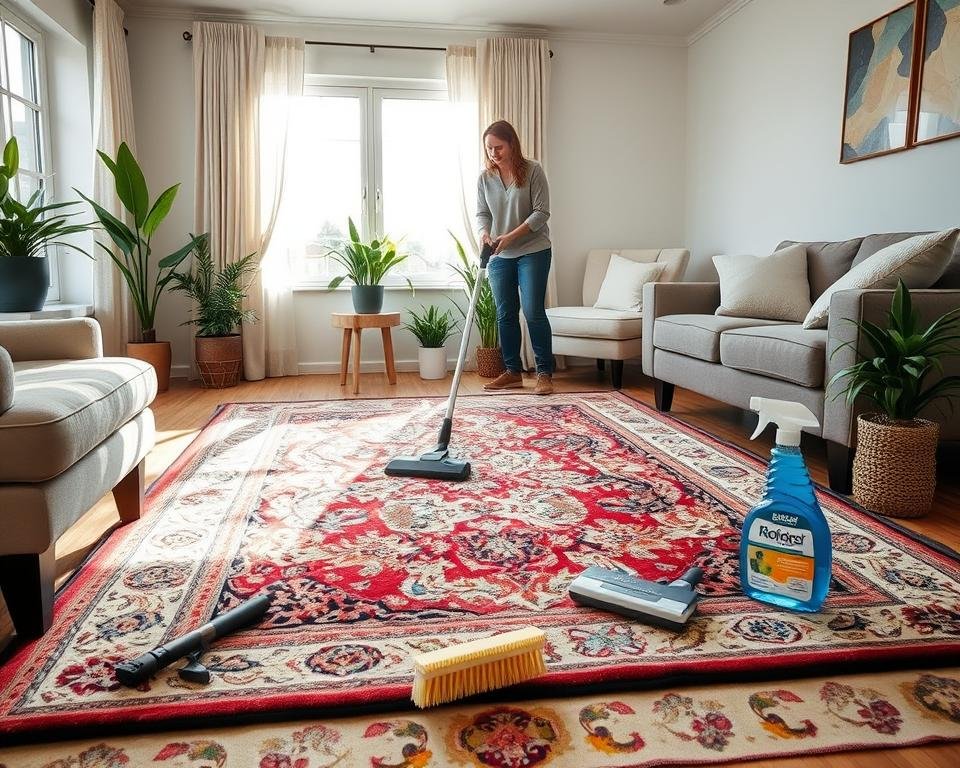
Layering Techniques and Style Tips
Rug layering is a hot design trend. It makes any space more interesting and functional. By layering rugs, you can fix size problems, play with colors and textures, and show off your style.
When layering rugs, the top one should be about 2/3 the size of the bottom one. This makes the look balanced. Make sure there’s 10 to 20 inches of bare floor around the rugs. A smaller rug on top can make a certain area stand out.
Choosing the right rugs is key. The bottom rug should fit the whole seating area. The top rug can add a pop of color or pattern. Start with a neutral rug as the base for a versatile look.
Layering rugs lets you play with colors, textures, and patterns. It works for any style, from eclectic to modern. It helps define areas and adds depth to your space.
To make rug layering work, use a rug pad. It keeps the rugs from slipping. Follow these rug layering tips to make your space look great and feel functional.
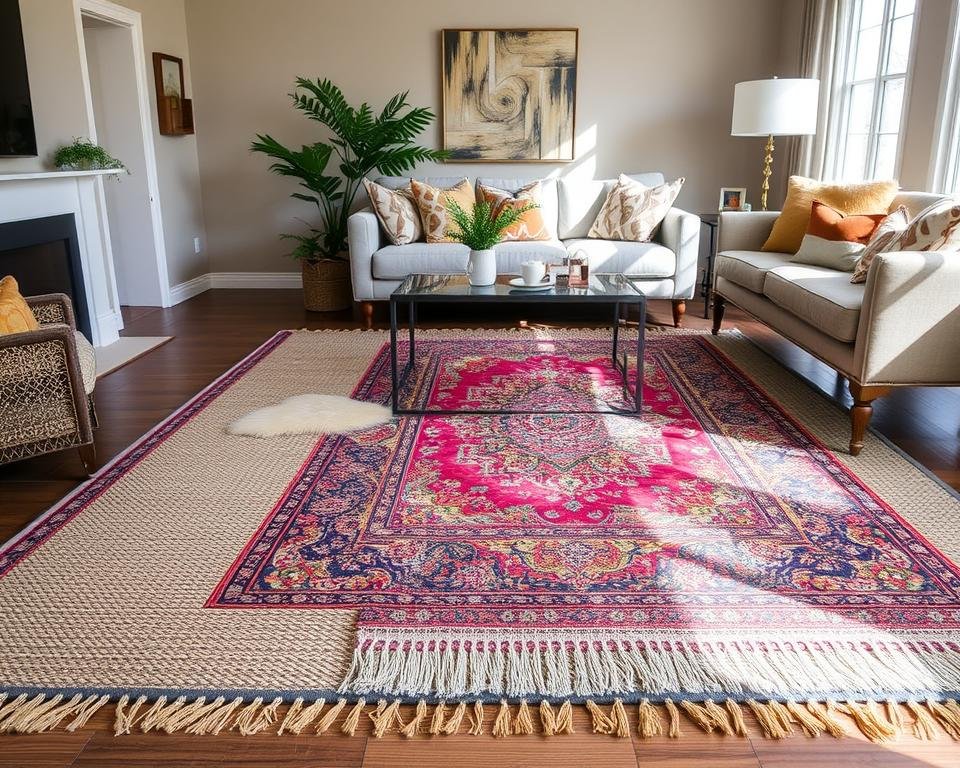
Runner Rugs for Hallways and Narrow Spaces
Adding a runner rug to your hallway or narrow space can change your home’s look and feel. These rugs are not just for looks. They also offer practical benefits that make them key to a well-designed home.
Sizing Guidelines
Choosing the right size for your runner rug is key. Leave at least 3 inches between the rug and the wall on each side. Don’t make the rug as long as your hallway to avoid an unbalanced look.
Make sure the front legs of furniture sit on or off the rug. For longer hallways, using multiple rugs might be a good idea. But, be careful not to create tripping hazards. Also, think about door clearance when picking the rug’s thickness.
Placement Tips
- Choose a runner rug that’s a bit shorter than your hallway or narrow space.
- Leave at least 3 inches between the rug and the wall on each side.
- Ensure that the front legs of any hallway furniture consistently sit on or off the runner rug.
- For longer hallways, consider using multiple runner rugs, but be mindful of the placement to avoid tripping hazards.
- Take door clearance into account when selecting the thickness of your runner rug.
By following these tips, you can pick a runner rug that looks great and works well in your hallway or narrow space.
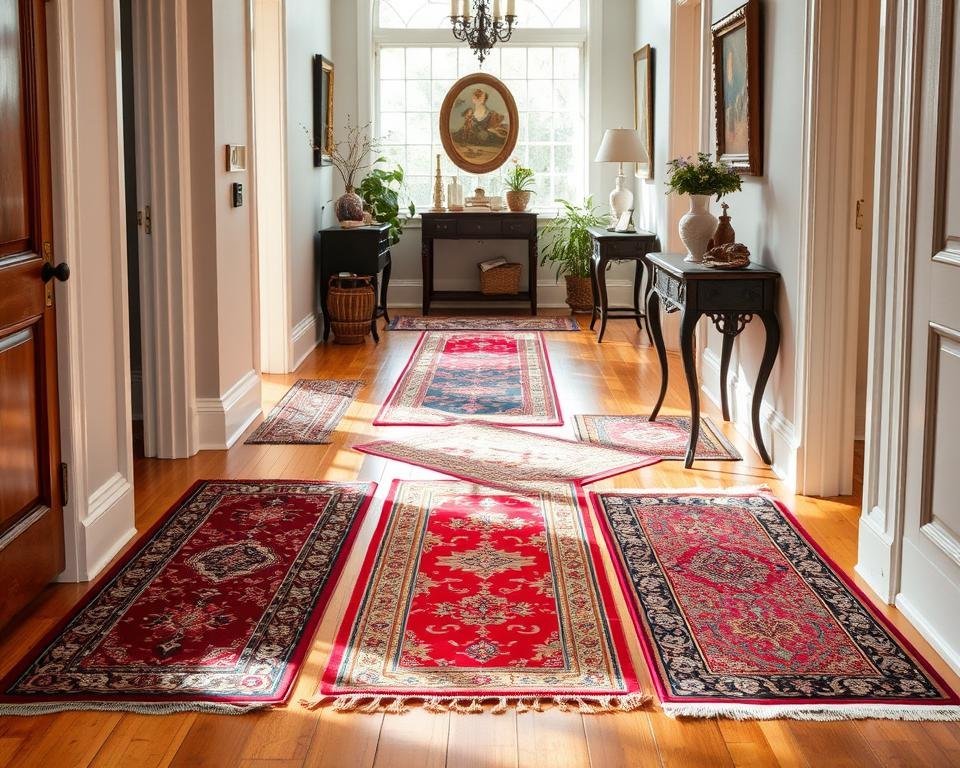
| Product | Price Range | Available Sizes | Material | Delivery |
|---|---|---|---|---|
| Nordic Knots Runner Rugs | $295.00 – $595.00 | 5’x8′ to 12’x15′, Custom Sizes | New Zealand Wool | 3-6 Business Days |
“The right runner rug can make all the difference in the world, transforming a plain hallway into a stylish and inviting space.”
When picking a runner rug, think about size, placement, and material. This ensures it fits well and looks good in your home.
Investment Considerations and Quality Markers
When you buy a rug, think about how long it will last and its quality. Hand-knotted rugs are pricier but can last for many years. Look for tight, even knots and rich, consistent colors. These show the rug’s high craftsmanship and quality materials.
Natural fibers like wool are more durable and valuable than synthetic ones. Think about where the rug will go. Spend more on areas that get a lot of use or on statement pieces. Save money on rugs for trends or temporary spots.
| Quality Marker | Significance |
|---|---|
| Tight, Even Knots | Shows skilled work and durability |
| Rich, Consistent Colors | Means high-quality dyes and materials |
| Natural Fibers (Wool, Silk, Cotton) | More durable and valuable long-term |
| High Knot Density | Means finer details and longer life |
A good dealer can teach you about rug design, origin, structure, and condition. This helps you make a confident rug investment. They might let you try rugs at home or offer trade-in options. This ensures you’re happy with your purchase.
“The investment value of a carpet has increased in recent years as demand has risen, making hand-knotted rugs a worthwhile long-term investment due to their beauty, workmanship, uniqueness, and quality.”
- Look at material quality, knot density, and types of knots used
- Understand the value of natural dyes and design harmony
- Appreciate the history and craftsmanship of high-quality rugs like Persian
By focusing on these rug quality markers, you can make a wise investment. This investment will add lasting beauty and value to your home.
Common Rug Selection Mistakes to Avoid
Choosing the perfect rug can change your space. But, avoid common mistakes. One big error is picking a rug that’s too small for the room. Interior designer Stacy Waggoner says a small rug can make the room look messy.
Experts suggest choosing a rug that goes beyond the furniture’s front legs. This makes the room feel bigger and more connected.
Another mistake is furniture that doesn’t match the rug. If some legs are on the rug and others aren’t, it looks like you didn’t plan it. To fix this, measure your space and place the rug correctly. Also, don’t forget a rug pad to prevent slipping and wear.
When picking a rug, think about how much use the space gets. High-pile rugs might not be best for busy areas. Designer Liz Lipkin recommends choosing a rug that fits the room’s purpose, like an “outdoor” rug for a family room.
Lastly, make sure your rug stands out from the floor. A rug that looks too much like the floor can make the room look dull. Choose a rug that clearly shows where the room starts and ends.
By avoiding these mistakes, your space will look better, feel more welcoming, and meet your needs.
| Mistake | Explanation | Expert Recommendation |
|---|---|---|
| Choosing a rug that’s too small | A rug that is too small for the room can make the space look disjointed and disorganized. | Choose a rug that extends beyond the front legs of your furniture or goes under all four feet to create a more cohesive and expansive feel. |
| Inconsistent furniture placement | If some furniture legs are on the rug while others are off, it can give the impression of an unintentional design. | Measure your space carefully and position the rug so that all furniture legs are either on or off the rug. |
| Neglecting rug pads | Failing to use a rug pad can lead to slipping and premature wear of the rug. | Invest in a quality rug pad that will protect your floors and keep the rug in place. |
| Choosing the wrong material | High-pile rugs may not be suitable for high-traffic areas, as they can be challenging to maintain. | Consider the purpose of the room and select a rug that’s fit for the intended use, such as an “outdoor” rug for a family room. |
| Blending rug and flooring | Rugs that blend too closely with the underlying floor can make the space appear lackluster and unintentional. | Look for rugs that provide a clear visual distinction from the flooring to define the boundaries of the room and create a more purposeful aesthetic. |
Conclusion
Choosing the right area rug for your home is important. You need to think about the room’s size, purpose, and your style. Make sure the rug fits well, matches the room’s use, and is easy to care for.
The perfect rug can change how your room looks and feels. It adds comfort, style, and brings everything together. Use the guide and tips from this article to find the best rug for your space.
Area rugs come in many materials, colors, and patterns. They let you make your home special and cozy. By choosing wisely, you can make any room feel welcoming and stylish, showing off your personal taste.
FAQ
What are the key factors to consider when selecting an area rug?
When picking an area rug, think about the room’s purpose and how much traffic it gets. Also, consider your lifestyle, budget, and the rug’s material, size, color, and pattern.
What are the benefits of using area rugs in a room?
Area rugs can make a room more stylish and comfortable. They also help with sound and define spaces. Plus, they protect floors, offer grip, and keep rooms warm.
What are the different types of rug materials and their properties?
There are many rug materials like wool, synthetic blends, and natural fibers like jute. Each has its own strengths, like durability, ease of cleaning, and being eco-friendly.
How do I determine the right rug size for my living room?
For living rooms, choose rugs that are 8’x10′ or 9’x12′. Make sure the rug is wider than your sofa by 6-8 inches on both sides. It should also match the sofa’s length, leaving 30-36 inches for walking.
What factors should I consider when choosing a rug for my dining room?
In dining rooms, go for rugs that are 8’x10′ or 9’x12′. Make sure there’s 36 inches from the table to the rug’s edge for chair movement. If you can, leave 12 inches between the rug and wall. Flatweave rugs work well here.
How do I determine the right rug size for my bedroom?
In bedrooms, the rug should be 24 inches wider than the bed on all sides. For a twin bed, a 5’x8′ rug is best. For a full, use a 6’x9′; for a queen, 8’x10′; and for a king, 9’x12′. Make sure the footboard’s legs are on the rug.
How do I choose the right colors and patterns for my rug?
Think about the room’s colors and use contrast wisely. Patterned rugs can add interest, but make sure the rug’s colors match the room’s for a unified look.
What are the pros and cons of natural versus synthetic rug materials?
Natural materials like wool and cotton are durable and good for the environment. They’re also hypoallergenic but can be pricey. Synthetic rugs are cheaper and easy to clean but might have chemicals.
How do I care for and maintain my area rug?
Vacuuming regularly is key for all rugs. Wool rugs are easy to clean because they repel dirt and spills. Flatweave rugs are the simplest to keep clean, but some rugs might need professional cleaning.
How can I use layering techniques to enhance my rug selection?
Layering a smaller rug over a larger one can solve size issues and add style. Make sure the base rug is big enough to anchor the area. The top rug should either match or contrast with the base for a cool look.


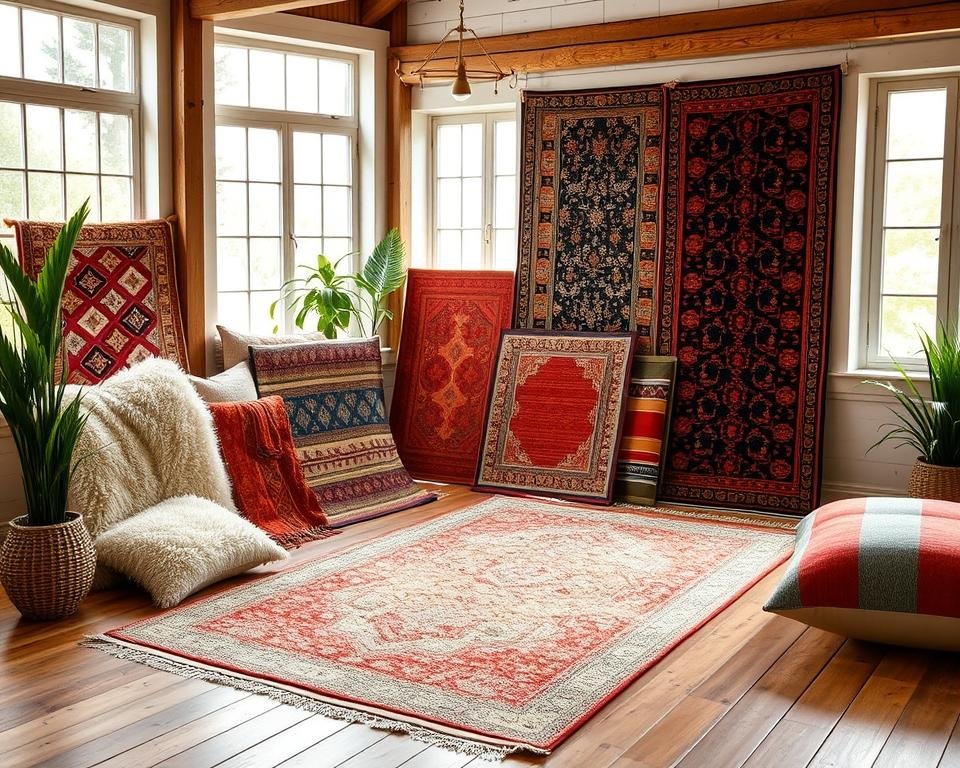
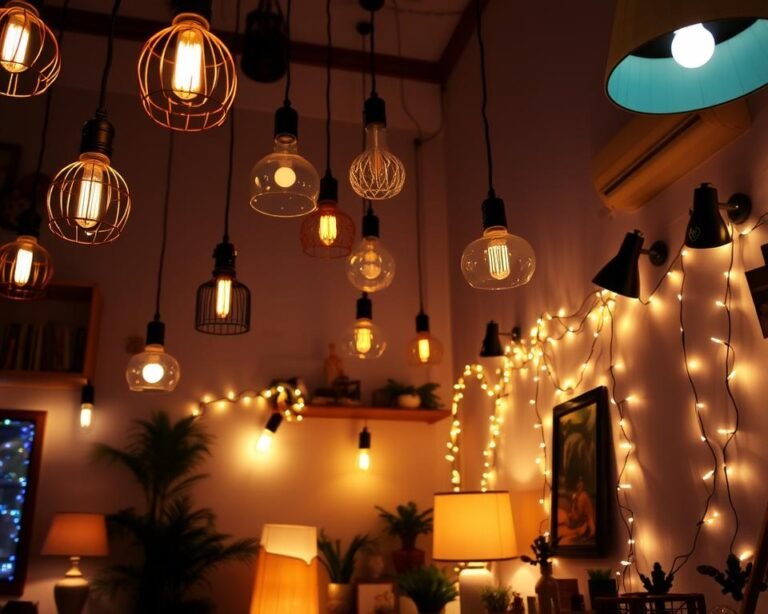
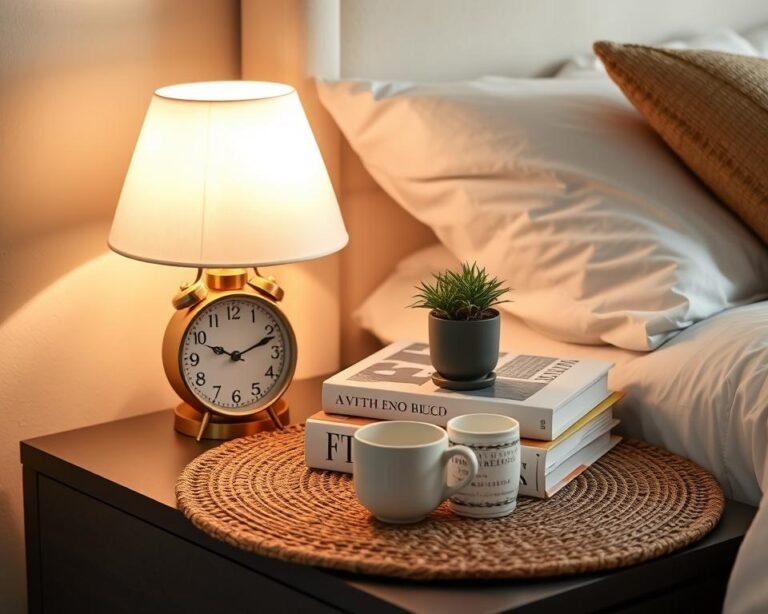
Leave a Comment